On-Boarding Training plan新员工培训计划
2024年酒店前台新入职员工培训计划范本(二篇)
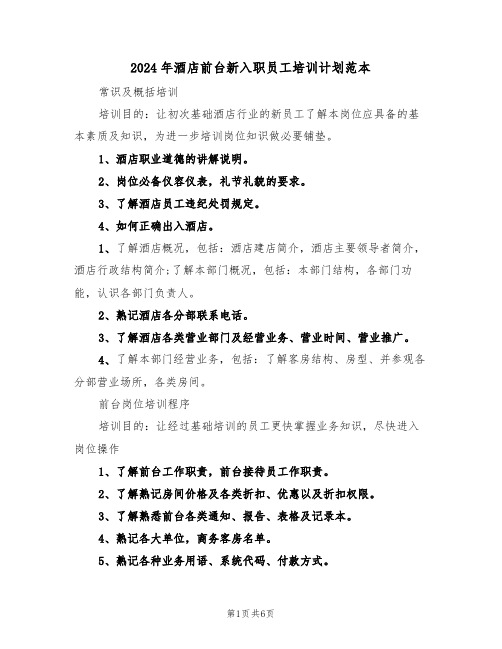
2024年酒店前台新入职员工培训计划范本常识及概括培训培训目的:让初次基础酒店行业的新员工了解本岗位应具备的基本素质及知识,为进一步培训岗位知识做必要铺垫。
1、酒店职业道德的讲解说明。
2、岗位必备仪容仪表,礼节礼貌的要求。
3、了解酒店员工违纪处罚规定。
4、如何正确出入酒店。
1、了解酒店概况,包括:酒店建店简介,酒店主要领导者简介,酒店行政结构简介;了解本部门概况,包括:本部门结构,各部门功能,认识各部门负责人。
2、熟记酒店各分部联系电话。
3、了解酒店各类营业部门及经营业务、营业时间、营业推广。
4、了解本部门经营业务,包括:了解客房结构、房型、并参观各分部营业场所,各类房间。
前台岗位培训程序培训目的:让经过基础培训的员工更快掌握业务知识,尽快进入岗位操作1、了解前台工作职责,前台接待员工作职责。
2、了解熟记房间价格及各类折扣、优惠以及折扣权限。
3、了解熟悉前台各类通知、报告、表格及记录本。
4、熟记各大单位,商务客房名单。
5、熟记各种业务用语、系统代码、付款方式。
6、了解前台所配用的设施设备及使用须知及方法。
培训内容1、培训前台日常操作流程,礼貌服务规范,交接班程序。
2、培训订房,订房之更改,取消程序,特殊折扣订房的处理方法。
3、培训前台卖房技巧。
4、培训vip接待程序、熟客订房及入住程序。
5、了解上机进行电脑模拟操作,包括入住、退房、预定等。
后____天1、培训更改房租程序。
2、了解客房升级的情形及标准。
3、入住登记程序培训。
4、结帐退房程序培训。
5、团体入住及结帐程序培训。
6、培训查ed(ed是预离房,c/o是脏房,ooo是待修房,h是保留房,occ住客房)。
7、培训转换房间的程序。
8、客用保险箱的使用程序培训。
9、客房参观及住客生日的处理。
10、补单的跟进程序。
11、培训接受客人留言,寄存物品服务的程序。
12、各类信用卡结算方法的培训。
13、以上培训均结合相关上机操作。
2024年酒店前台新入职员工培训计划范本(二)一、培训目标1. 熟悉酒店前台工作流程和相关制度规定;2. 掌握与客户沟通的技巧和礼仪;3. 熟练使用前台系统软件和办公设备;4. 培养团队协作意识和服务意识;5. 提高工作效率和处理问题的能力。
新员工培训计划的英语缩写
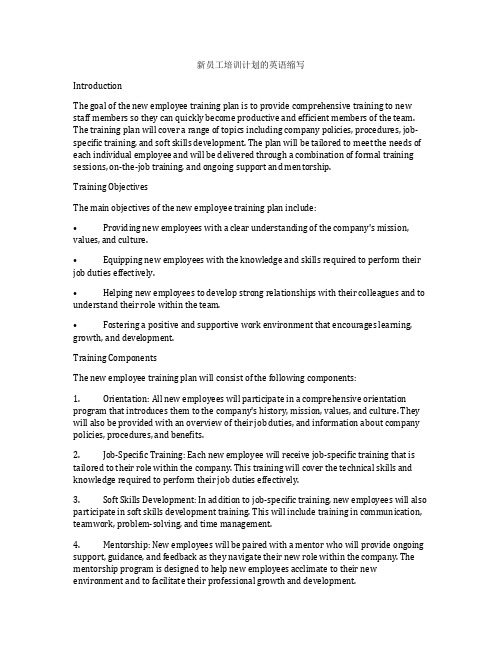
新员工培训计划的英语缩写IntroductionThe goal of the new employee training plan is to provide comprehensive training to new staff members so they can quickly become productive and efficient members of the team. The training plan will cover a range of topics including company policies, procedures, job-specific training, and soft skills development. The plan will be tailored to meet the needs of each individual employee and will be delivered through a combination of formal training sessions, on-the-job training, and ongoing support and mentorship.Training ObjectivesThe main objectives of the new employee training plan include:•Providing new employees with a clear understanding of the company's mission, values, and culture.•Equipping new employees with the knowledge and skills required to perform their job duties effectively.•Helping new employees to develop strong relationships with their colleagues and to understand their role within the team.•Fostering a positive and supportive work environment that encourages learning, growth, and development.Training ComponentsThe new employee training plan will consist of the following components:1. Orientation: All new employees will participate in a comprehensive orientation program that introduces them to the company's history, mission, values, and culture. They will also be provided with an overview of their job duties, and information about company policies, procedures, and benefits.2. Job-Specific Training: Each new employee will receive job-specific training that is tailored to their role within the company. This training will cover the technical skills and knowledge required to perform their job duties effectively.3. Soft Skills Development: In addition to job-specific training, new employees will also participate in soft skills development training. This will include training in communication, teamwork, problem-solving, and time management.4. Mentorship: New employees will be paired with a mentor who will provide ongoing support, guidance, and feedback as they navigate their new role within the company. The mentorship program is designed to help new employees acclimate to their new environment and to facilitate their professional growth and development.5. Ongoing Support: In addition to formal training sessions, new employees will have access to ongoing support and resources to help them succeed in their new role. This may include access to online training modules, one-on-one coaching sessions, and ongoing feedback from their manager.Training DeliveryThe new employee training plan will be delivered through a combination of formal training sessions, on-the-job training, and ongoing support and mentorship. The following methods will be used to deliver training:•In-Person Training: New employees will attend in-person training sessions where they will have the opportunity to interact with trainers and other new employees. These sessions may include presentations, group discussions, and hands-on activities.•Online Training: In addition to in-person training, new employees will have access to online training modules that cover a range of topics including company policies, procedures, and job-specific training.•On-The-Job Training: New employees will receive on-the-job training where they will work alongside experienced staff members to learn the ins and outs of their role.•Mentorship: New employees will be paired with a mentor who will provide ongoing support, guidance, and feedback as they navigate their new role within the company.Training EvaluationTo ensure the effectiveness of the new employee training plan, regular evaluations will be conducted to measure the progress and performance of new employees. This will include both qualitative and quantitative measures such as feedback from managers, peers, and mentors, as well as performance metrics related to job duties and goals. Based on the evaluations, adjustments will be made to the training plan to ensure that new employees are receiving the support and resources they need to succeed in their new role. ConclusionThe new employee training plan is designed to provide comprehensive training to new employees so they can quickly become productive and efficient members of the team. The plan will cover a range of topics including company policies, procedures, job-specific training, and soft skills development, and will be delivered through a combination of formal training sessions, on-the-job training, and ongoing support and mentorship. Regular evaluations will be conducted to ensure the effectiveness of the training plan and to make adjustments as needed. With this training plan in place, new employees will have the knowledge, skills, and support they need to succeed in their new role within the company.。
pa入职21天培训计划

pa入职21天培训计划第一天:公司介绍和规章制度培训上午:公司领导发表欢迎词,介绍公司的发展历程、企业文化、产品与服务,并对员工的期望进行明确说明。
下午:人力资源部门领导讲解公司的规章制度、员工手册以及各项制度的执行要求,让新员工了解公司的基本规定,避免入职后出现违规行为。
第二天:岗位职责培训上午:各部门主管介绍各个部门的基本职能和工作内容,让新员工初步了解自己所在部门的业务范围和工作内容。
下午:针对实际岗位进行详细的岗位培训,让新员工了解自己的工作职责及要求,并介绍实际工作中可能遇到的问题及解决方法。
第三至第五天:产品知识培训上午:产品部门对公司的产品进行详细介绍,包括产品的功能特点、适用范围、竞争对手等,让新员工对公司的产品有更深入的了解。
下午:模拟销售培训,让新员工了解销售流程和技巧,提高销售能力。
第六至第九天:市场营销培训上午:市场部门介绍公司的市场战略、销售策略、市场营销推广、宣传渠道等,让新员工了解公司的市场定位和推广方法。
下午:市场调研培训,让新员工了解如何进行市场调研,了解市场需求,做好产品定位。
第十至第十三天:客户服务培训上午:客户服务部门介绍公司的客户服务理念、服务流程、服务技巧等,让新员工了解公司对客户服务的要求。
下午:模拟客户服务培训,让新员工了解如何与客户建立良好的沟通关系,提升客户服务能力。
第十四至第十七天:团队协作培训上午:团队协作培训,教导新员工如何与团队成员合作,解决团队内部矛盾,提高团队效率。
下午:沟通技巧培训,让新员工了解良好的沟通在团队协作中的重要性,提高沟通能力。
第十八至第二十天:领导力培训上午:领导力培训,让新员工了解领导力的重要性,培养团队领导能力。
下午:职业规划培训,教导新员工如何规划个人的职业生涯,为未来的职业发展做好准备。
第二十一天:总结与考核上午:对整个培训过程进行总结,听取新员工的意见和建议,并对未来工作提出期望和要求。
下午:培训考核,对新员工进行入职考核,确保新员工对公司的各项内容有深入了解,并能够顺利上岗工作。
酒店新员工入职培训工作计划
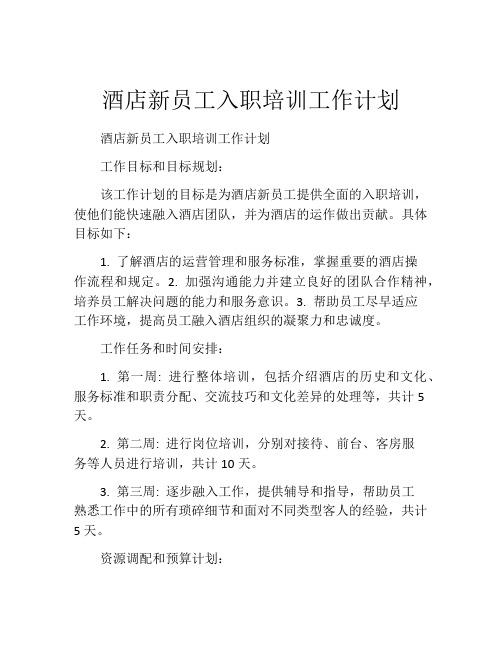
酒店新员工入职培训工作计划酒店新员工入职培训工作计划工作目标和目标规划:该工作计划的目标是为酒店新员工提供全面的入职培训,使他们能快速融入酒店团队,并为酒店的运作做出贡献。
具体目标如下:1. 了解酒店的运营管理和服务标准,掌握重要的酒店操作流程和规定。
2. 加强沟通能力并建立良好的团队合作精神,培养员工解决问题的能力和服务意识。
3. 帮助员工尽早适应工作环境,提高员工融入酒店组织的凝聚力和忠诚度。
工作任务和时间安排:1. 第一周: 进行整体培训,包括介绍酒店的历史和文化、服务标准和职责分配、交流技巧和文化差异的处理等,共计5天。
2. 第二周: 进行岗位培训,分别对接待、前台、客房服务等人员进行培训,共计10天。
3. 第三周: 逐步融入工作,提供辅导和指导,帮助员工熟悉工作中的所有琐碎细节和面对不同类型客人的经验,共计5天。
资源调配和预算计划:1. 资源调配:为确保培训质量,需要调配具有拥有丰富酒店业经验的领导者、经理等人员作为培训师傅。
2. 预算计划:包括培训场地、培训材料、餐食及零用费等,需提前预算并确保经费安排得当。
项目风险评估和管理:考虑到培训的复杂性和许多因素的干扰,我们需要加强风险管理,确保培训顺利完成。
具体风险如下:1. 意外受伤或病情恶化。
2. 重要资源非正常途径离职。
为应对这些风险,我们应该采取防范措施:对每位参与培训的员工进行健康检查,确保身体合理;定期与员工沟通,了解情况,极力避免资源流失。
工作绩效管理:1. 培训效果调查:在培训结束后,我们需要形成问卷,了解员工对培训的反馈,并及时调整提高培训质量。
2. 员工绩效评估:通过实践考核,确定员工在各个工作方面的绩效表现,及时调整员工岗位,并按照绩效结果给予节假日和薪酬等激励措施。
作沟通和协调:为了确保培训质量和效果,酒店将与参与学员和领导层进行密切的沟通和协调,了解参与培训的员工的进展情况,并根据进展情况作出调整。
工作总结和复盘:在培训活动结束后,我们将根据反馈意见、学员表现和员工考核等确立的标准进行总结和安排。
入职计划英语
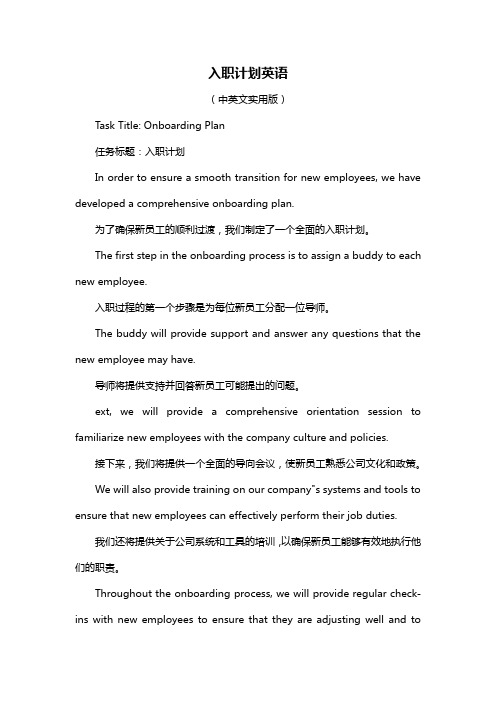
入职计划英语(中英文实用版)Task Title: Onboarding Plan任务标题:入职计划In order to ensure a smooth transition for new employees, we have developed a comprehensive onboarding plan.为了确保新员工的顺利过渡,我们制定了一个全面的入职计划。
The first step in the onboarding process is to assign a buddy to each new employee.入职过程的第一个步骤是为每位新员工分配一位导师。
The buddy will provide support and answer any questions that the new employee may have.导师将提供支持并回答新员工可能提出的问题。
ext, we will provide a comprehensive orientation session to familiarize new employees with the company culture and policies.接下来,我们将提供一个全面的导向会议,使新员工熟悉公司文化和政策。
We will also provide training on our company"s systems and tools to ensure that new employees can effectively perform their job duties.我们还将提供关于公司系统和工具的培训,以确保新员工能够有效地执行他们的职责。
Throughout the onboarding process, we will provide regular check-ins with new employees to ensure that they are adjusting well and toaddress any concerns they may have.在整个入职过程中,我们将与新员工进行定期的跟进,以确保他们适应良好,并解决他们可能遇到的问题。
酒店员工入职培训计划
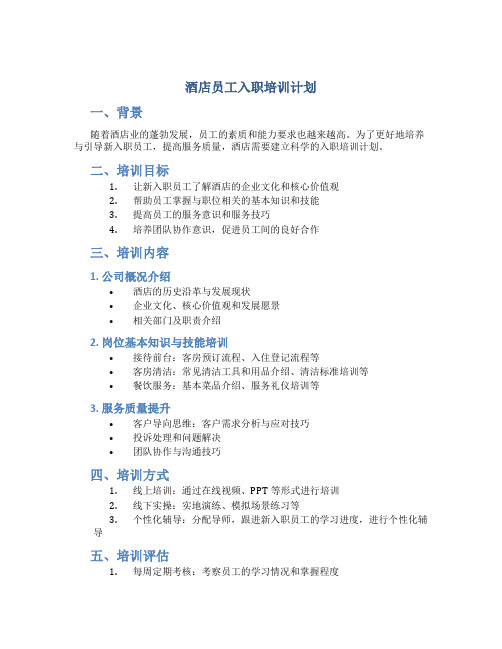
酒店员工入职培训计划
一、背景
随着酒店业的蓬勃发展,员工的素质和能力要求也越来越高。
为了更好地培养与引导新入职员工,提高服务质量,酒店需要建立科学的入职培训计划。
二、培训目标
1.让新入职员工了解酒店的企业文化和核心价值观
2.帮助员工掌握与职位相关的基本知识和技能
3.提高员工的服务意识和服务技巧
4.培养团队协作意识,促进员工间的良好合作
三、培训内容
1. 公司概况介绍
•酒店的历史沿革与发展现状
•企业文化、核心价值观和发展愿景
•相关部门及职责介绍
2. 岗位基本知识与技能培训
•接待前台:客房预订流程、入住登记流程等
•客房清洁:常见清洁工具和用品介绍、清洁标准培训等
•餐饮服务:基本菜品介绍、服务礼仪培训等
3. 服务质量提升
•客户导向思维:客户需求分析与应对技巧
•投诉处理和问题解决
•团队协作与沟通技巧
四、培训方式
1.线上培训:通过在线视频、PPT等形式进行培训
2.线下实操:实地演练、模拟场景练习等
3.个性化辅导:分配导师,跟进新入职员工的学习进度,进行个性化辅
导
五、培训评估
1.每周定期考核:考察员工的学习情况和掌握程度
2.约谈研讨会:定期组织交流研讨,收集员工反馈并进行改进
六、总结
通过科学合理的入职培训计划,可以帮助新员工尽快适应工作环境,提高工作效率和服务质量,有利于酒店提升整体竞争力。
希望此培训计划能够对酒店员工的入职培训工作起到积极的促进作用。
新员工培训计划
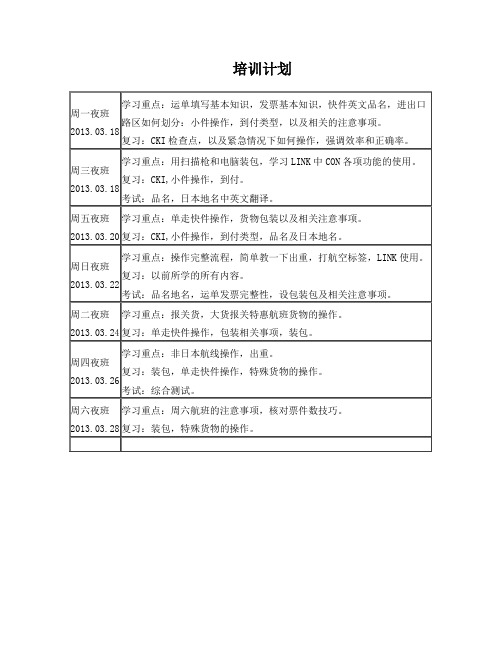
周二夜班
2013.03.24
学习重点:报关货,大货报关特惠航班货物的操作。
复习:单走快件操作,包装相关事项,装包。
周四夜班
2013.03.26
学习重点:非日本航线操作,出重。
复习:装包,单走快件操作,特殊货物的操作。
考试:综合测试。
周六夜班
2013.03.28
培训计划
周一夜班
2013.03.18
学习重点:运单填写基本知识,发票基本知识,快件英文品名,进出口路区如何划分:小件操作,到付类型,以及相关的注意事项。
复习:CKI检查点,以及紧急情况下如何操作,强调效率和正确率。
周三夜班
2013.03.18
学习重点:用扫描枪和电脑装包,学习LINK中CON各项功能的使用。
学习重点:周六航班的注意事项,核对票件数技巧。
复习:装包,特殊货物的操作。
复习:CKI,小件操作,到付。
考试:品名,日本地名中英文翻译。
周五夜班
2013.03.20
学习重点:单走快件操作,货物包装以及相关注意事项。
复习:CKI,小件操作,到付类型,品名及日本地名。
周日夜班
2013.03.22
学习重点:操作完整流程,简单教一下出重,打航空标签,LINK
酒店培训新员工计划方案
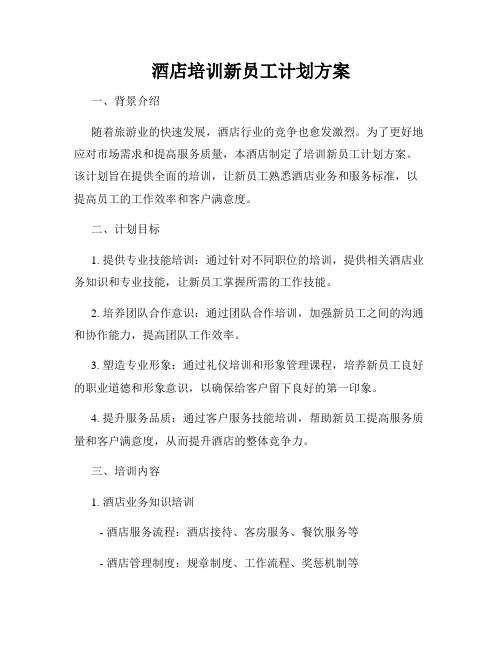
酒店培训新员工计划方案一、背景介绍随着旅游业的快速发展,酒店行业的竞争也愈发激烈。
为了更好地应对市场需求和提高服务质量,本酒店制定了培训新员工计划方案。
该计划旨在提供全面的培训,让新员工熟悉酒店业务和服务标准,以提高员工的工作效率和客户满意度。
二、计划目标1. 提供专业技能培训:通过针对不同职位的培训,提供相关酒店业务知识和专业技能,让新员工掌握所需的工作技能。
2. 培养团队合作意识:通过团队合作培训,加强新员工之间的沟通和协作能力,提高团队工作效率。
3. 塑造专业形象:通过礼仪培训和形象管理课程,培养新员工良好的职业道德和形象意识,以确保给客户留下良好的第一印象。
4. 提升服务品质:通过客户服务技能培训,帮助新员工提高服务质量和客户满意度,从而提升酒店的整体竞争力。
三、培训内容1. 酒店业务知识培训- 酒店服务流程:酒店接待、客房服务、餐饮服务等- 酒店管理制度:规章制度、工作流程、奖惩机制等- 酒店产品及设施介绍:房型、会议设施、餐厅等2. 专业技能培训- 客房清洁技巧:床铺整理、卫生间清洁、日常清洁用品的使用等 - 前台接待技巧:预定管理、办理入住、咨询解答等- 餐饮服务技巧:点菜推荐、餐具摆放、用餐礼仪等3. 团队合作培训- 团队协作训练:拓展训练、团队游戏等,促进团队之间的协作和互信- 沟通技巧培训:学习有效的沟通技巧,提高员工之间的沟通效率和准确性4. 礼仪培训和形象管理- 职业形象塑造:仪容仪表、穿戴得体、言谈举止等- 礼仪规范培训:问候礼仪、用餐礼仪、电话礼仪等5. 客户服务技能培训- 主动服务技巧:主动询问需求、关怀客户情况等- 妥善处理客诉:处理客户投诉、解决问题的技巧等- 个人服务技能提升:面对面服务、电话服务等四、培训方式1. 理论培训- 通过讲座、教学视频等方式传授酒店业务知识和专业技能- 提供培训手册和学习材料以供员工学习和参考2. 实践培训- 安排新员工在各个岗位进行实践培训,包括模拟接待、客房清洁、餐厅服务等- 由经验丰富的员工进行辅导和指导,帮助新员工提高工作技能和熟悉工作流程3. 现场观摩- 安排新员工观摩其他岗位的工作,了解酒店各个部门的工作内容和流程- 拓宽视野,提高员工对整个酒店运营的全面理解五、培训考核与评估1. 考核方式- 设置理论知识测试,评估新员工对酒店业务知识的掌握情况- 安排实际操作考核,测试新员工在模拟情景中的工作表现2. 考核标准- 考察新员工对培训内容的理解和掌握程度- 评估新员工的工作技能和服务质量- 考核结果与实际表现相结合,综合评估新员工的综合能力六、培训后续1. 培训成果反馈- 针对新员工的培训成果,确保培训目标达到预期效果- 根据培训成果进行总结和反馈,为后续培训提供改进参考2. 定期复训- 针对酒店员工的培训需求,制定合适的定期复训计划,确保员工的业务水平和服务意识持续提升结语通过本酒店的培训新员工计划方案,我们将为新员工们提供全面的培训,让他们迅速适应工作岗位,提高工作效率和服务质量。
入职培训计划提案模板
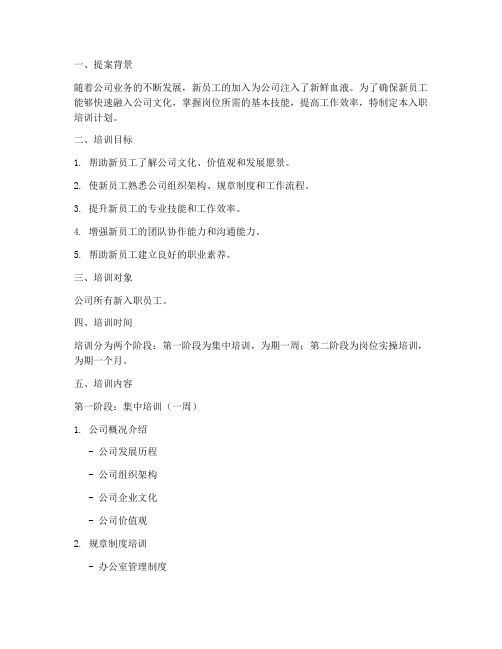
一、提案背景随着公司业务的不断发展,新员工的加入为公司注入了新鲜血液。
为了确保新员工能够快速融入公司文化,掌握岗位所需的基本技能,提高工作效率,特制定本入职培训计划。
二、培训目标1. 帮助新员工了解公司文化、价值观和发展愿景。
2. 使新员工熟悉公司组织架构、规章制度和工作流程。
3. 提升新员工的专业技能和工作效率。
4. 增强新员工的团队协作能力和沟通能力。
5. 帮助新员工建立良好的职业素养。
三、培训对象公司所有新入职员工。
四、培训时间培训分为两个阶段:第一阶段为集中培训,为期一周;第二阶段为岗位实操培训,为期一个月。
五、培训内容第一阶段:集中培训(一周)1. 公司概况介绍- 公司发展历程- 公司组织架构- 公司企业文化- 公司价值观2. 规章制度培训- 办公室管理制度- 考勤制度- 奖惩制度- 安全生产制度3. 岗位技能培训- 岗位职责- 工作流程- 专业技能培训4. 团队建设与沟通技巧- 团队合作的重要性- 沟通技巧- 领导力培训第二阶段:岗位实操培训(一个月)1. 跟岗实习- 新员工跟随导师进行实际工作,了解岗位操作流程。
2. 定期辅导- 每周安排导师对新员工进行辅导,解答疑问,提供指导。
3. 技能考核- 每月对新员工进行技能考核,检验培训效果。
4. 总结与反馈- 每月组织新员工进行培训总结,收集反馈意见,不断优化培训内容。
六、培训师资1. 公司高层领导2. 各部门负责人3. 具有丰富经验的资深员工4. 外部专业培训机构七、培训方式1. 讲座2. 案例分析3. 角色扮演4. 小组讨论5. 实地考察6. 在线学习平台八、培训预算根据培训内容和师资情况,预计培训总费用为人民币XX万元。
九、培训评估1. 培训结束后,对新员工进行满意度调查,了解培训效果。
2. 通过岗位技能考核,评估新员工的学习成果。
3. 定期跟踪新员工的工作表现,了解培训后的实际应用情况。
十、实施计划1. 制定详细的培训计划,明确培训时间、地点、内容、师资等。
新人培训计划英语
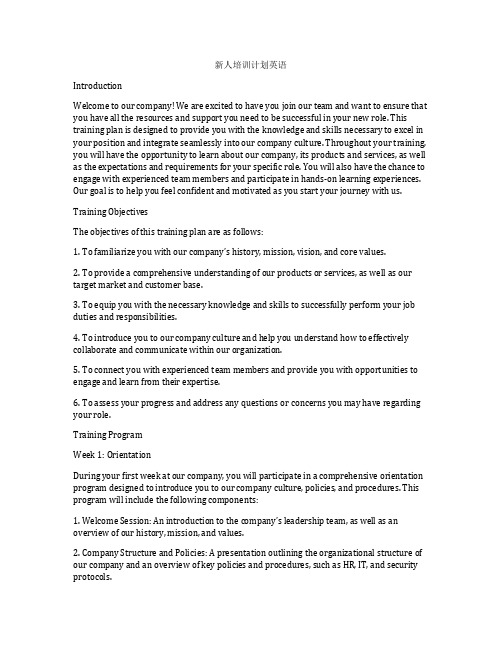
新人培训计划英语IntroductionWelcome to our company! We are excited to have you join our team and want to ensure that you have all the resources and support you need to be successful in your new role. This training plan is designed to provide you with the knowledge and skills necessary to excel in your position and integrate seamlessly into our company culture. Throughout your training, you will have the opportunity to learn about our company, its products and services, as well as the expectations and requirements for your specific role. You will also have the chance to engage with experienced team members and participate in hands-on learning experiences. Our goal is to help you feel confident and motivated as you start your journey with us. Training ObjectivesThe objectives of this training plan are as follows:1. To familiarize you with our company’s history, mission, vision, and core values.2. To provide a comprehensive understanding of our products or services, as well as our target market and customer base.3. To equip you with the necessary knowledge and skills to successfully perform your job duties and responsibilities.4. To introduce you to our company culture and help you understand how to effectively collaborate and communicate within our organization.5. To connect you with experienced team members and provide you with opportunities to engage and learn from their expertise.6. To assess your progress and address any questions or concerns you may have regarding your role.Training ProgramWeek 1: OrientationDuring your first week at our company, you will participate in a comprehensive orientation program designed to introduce you to our company culture, policies, and procedures. This program will include the following components:1. Welcome Sessi on: An introduction to the company’s leadership team, as well as an overview of our history, mission, and values.2. Company Structure and Policies: A presentation outlining the organizational structure of our company and an overview of key policies and procedures, such as HR, IT, and security protocols.3. Product or Service Training: An in-depth review of our products or services, including their features, benefits, and value proposition. This training will be conducted by relevant department heads and product managers.4. Team Building Activities: Group activities and icebreakers designed to help you get to know your colleagues and establish a sense of camaraderie and solidarity.5. New Employee Resources: A tour of the office, an introduction to our online learning platform, and an overview of available resources and support systems for new employees. Week 2-3: Job-Specific TrainingFollowing orientation, you will undergo job-specific training tailored to your role within the company. This training will be customized according to the department in which you are working and the requirements of your position. Key components of this training may include:1. Role Responsibilities: An in-depth review of the specific duties and responsibilities associated with your position, as well as the expectations for performance and success.2. Training Modules: A series of online or in-person training modules designed to familiarize you with the technical aspects of your role, such as software systems, data management, or job-specific processes.3. Shadowing Opportunities: The chance to observe and learn from experienced team members as they perform their job duties, providing you with a real-world understanding of the tasks you will be expected to handle.4. Hands-On Learning: Practical exercises and simulations designed to reinforce your learning and allow you to practice the skills required for your job.Week 4-5: Integration and Skill DevelopmentAt this stage of your training, you will have the opportunity to integrate and collaborate with your team members, as well as further develop your skills and competencies. This phase may include:1. Team Meetings and Collaboration: Integration into departmental or team meetings, as well as the chance to participate in group projects or initiatives.2. Skills Development Workshops: Workshops or seminars focused on building particular skills relevant to your role, such as communication, time management, or problem-solving.3. Performance Evaluation: A mid-point evaluation to assess your progress, identify areas of strength and areas for improvement, and establish a plan for ongoing training and support.4. Mentorship Opportunities: Pairing with a mentor or trusted advisor within the company who can provide guidance, support, and feedback as you acclimate to your new role.Week 6-8: Final Assessment and Ongoing SupportDuring the final phase of your training, you will undergo a final assessment to evaluate your readiness for fully integrating into your role and the company. This phase may include:1. Role-Play and Simulations: Opportunities to engage in role-play exercises and simulations to demonstrate your knowledge and skills in real-life scenarios.2. Final Evaluation: A comprehensive evaluation of your overall performance and understanding of your role, as well as a plan for ongoing development and support.3. Q&A Sessions: Open forums and one-on-one discussions to address any remaining questions or concerns you may have before transitioning into your role full-time.4. Continuing Education: An overview of ongoing learning and development opportunities available to you within the company, including workshops, webinars, and resources for personal and professional growth.ConclusionWe believe that this training plan will provide you with the confidence, knowledge, and resources necessary to succeed in your new role within our company. We are committed to your success and are excited to support you as you embark on this new journey. If you have any questions or require additional information, please do not hesitate to reach out to your supervisor or the HR department for assistance. We wish you the best of luck as you begin this exciting new chapter with us!Sincerely,[Company Name] Management Team。
讨论新员工培训计划英语
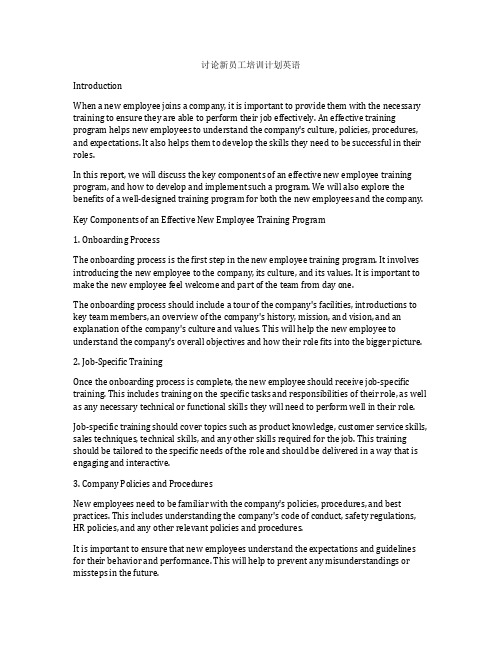
讨论新员工培训计划英语IntroductionWhen a new employee joins a company, it is important to provide them with the necessary training to ensure they are able to perform their job effectively. An effective training program helps new employees to understand the company's culture, policies, procedures, and expectations. It also helps them to develop the skills they need to be successful in their roles.In this report, we will discuss the key components of an effective new employee training program, and how to develop and implement such a program. We will also explore the benefits of a well-designed training program for both the new employees and the company.Key Components of an Effective New Employee Training Program1. Onboarding ProcessThe onboarding process is the first step in the new employee training program. It involves introducing the new employee to the company, its culture, and its values. It is important to make the new employee feel welcome and part of the team from day one.The onboarding process should include a tour of the company's facilities, introductions to key team members, an overview of the company's history, mission, and vision, and an explanation of the company's culture and values. This will help the new employee to understand the company's overall objectives and how their role fits into the bigger picture.2. Job-Specific TrainingOnce the onboarding process is complete, the new employee should receive job-specific training. This includes training on the specific tasks and responsibilities of their role, as well as any necessary technical or functional skills they will need to perform well in their role. Job-specific training should cover topics such as product knowledge, customer service skills, sales techniques, technical skills, and any other skills required for the job. This training should be tailored to the specific needs of the role and should be delivered in a way that is engaging and interactive.3. Company Policies and ProceduresNew employees need to be familiar with the company's policies, procedures, and best practices. This includes understanding the company's code of conduct, safety regulations, HR policies, and any other relevant policies and procedures.It is important to ensure that new employees understand the expectations and guidelines for their behavior and performance. This will help to prevent any misunderstandings or missteps in the future.4. Soft Skills TrainingIn addition to job-specific skills, new employees should also receive training in soft skills such as communication, teamwork, time management, and problem-solving. These skills are important for success in any role and are often overlooked in training programs.Soft skills training can include activities such as role-playing, group discussions, and interactive exercises that help new employees to develop these important skills. This type of training helps new employees to adapt to the company culture, develop effective working relationships, and become more productive in their roles.Developing and Implementing a New Employee Training Program1. Assess Training NeedsThe first step in developing a new employee training program is to assess the training needs of the new employees. This involves understanding the skills, knowledge, and experience required for the specific role, as well as any gaps that need to be filled.This can be done through surveys, interviews, or discussions with the hiring manager or department head. The goal is to identify the specific training needs of the new employee so that the training program can be tailored to meet those needs.2. Define Learning ObjectivesOnce the training needs have been identified, the next step is to define the learning objectives for the new employee training program. This involves determining what the new employee should be able to do or understand after completing the training program.Learning objectives should be specific, measurable, achievable, relevant, and time-bound (SMART). They should clearly outline the skills, knowledge, and behaviors that the new employee should develop as a result of the training program.3. Design Training Materials and ActivitiesOnce the learning objectives have been defined, the next step is to design the training materials and activities. This involves creating or selecting the content, resources, and activities that will be used to deliver the training.Training materials can include written materials, presentations, videos, e-learning modules, and other resources. Training activities can include role-playing, group discussions, case studies, and practical exercises. The goal is to create engaging and interactive training materials and activities that will help new employees to learn and retain the information. 4. Implement Training ProgramOnce the training materials and activities have been designed, the next step is to implement the training program. This involves scheduling the training sessions, assigning trainers, and ensuring that all necessary resources are in place.The implementation of the training program should be well-organized and smooth, with clear communication and support for the new employees. It is also important to solicit feedback from the new employees to ensure that the training program is meeting their needs.5. Evaluate Training EffectivenessAfter the training program has been implemented, it is important to evaluate its effectiveness. This involves gathering feedback from the new employees, as well as tracking their performance and progress after the training.It is important to determine whether the learning objectives have been met, and whether the new employees are able to apply what they have learned in their roles. This information will help to identify any areas for improvement in the training program and make necessary adjustments for future training programs.Benefits of an Effective New Employee Training ProgramAn effective new employee training program provides a number of benefits for both the new employees and the company. These benefits include:- Improved employee performance and productivity: Training helps new employees to develop the skills and knowledge they need to perform their roles effectively, leading to improved performance and productivity.- Reduced turnover: A well-designed training program makes new employees feel more confident in their roles and more connected to the company, reducing turnover and increasing retention rates.- Enhanced company culture: Training helps new employees to understand and embrace the company's culture, values, and expectations, leading to a more cohesive and engaged workforce.- Increased customer satisfaction: Well-trained employees are better able to meet customer needs and expectations, leading to increased customer satisfaction and loyalty. ConclusionAn effective new employee training program is an essential part of welcoming and integrating new employees into a company. By providing new employees with the training they need to be successful in their roles, companies can improve performance, productivity, and employee satisfaction. Developing and implementing a new employee training program involves assessing training needs, defining learning objectives, designing training materialsand activities, implementing the program, and evaluating its effectiveness. The benefits of an effective training program are numerous, and can have a positive impact on both new employees and the company as a whole.。
boss training plan
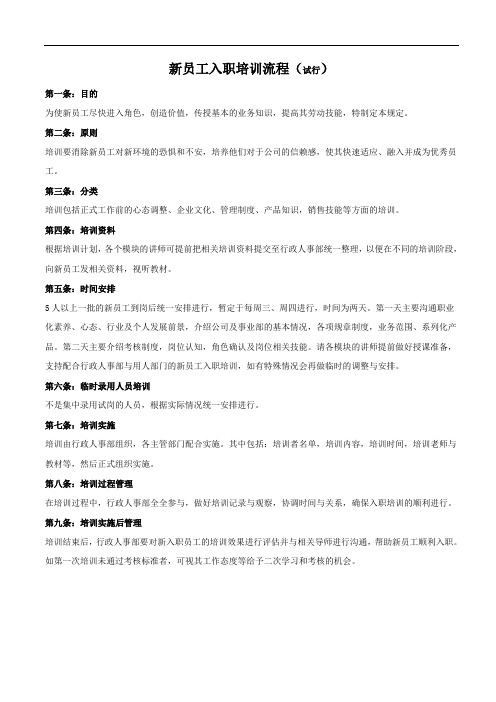
新员工入职培训流程(试行)第一条:目的为使新员工尽快进入角色,创造价值,传授基本的业务知识,提高其劳动技能,特制定本规定。
第二条:原则培训要消除新员工对新环境的恐惧和不安,培养他们对于公司的信赖感,使其快速适应、融入并成为优秀员工。
第三条:分类培训包括正式工作前的心态调整、企业文化、管理制度、产品知识,销售技能等方面的培训。
第四条:培训资料根据培训计划,各个模块的讲师可提前把相关培训资料提交至行政人事部统一整理,以便在不同的培训阶段,向新员工发相关资料,视听教材。
第五条:时间安排5人以上一批的新员工到岗后统一安排进行,暂定于每周三、周四进行,时间为两天。
第一天主要沟通职业化素养、心态、行业及个人发展前景,介绍公司及事业部的基本情况,各项规章制度,业务范围、系列化产品。
第二天主要介绍考核制度,岗位认知,角色确认及岗位相关技能。
请各模块的讲师提前做好授课准备,支持配合行政人事部与用人部门的新员工入职培训,如有特殊情况会再做临时的调整与安排。
第六条:临时录用人员培训不是集中录用试岗的人员,根据实际情况统一安排进行。
第七条:培训实施培训由行政人事部组织,各主管部门配合实施。
其中包括:培训者名单,培训内容,培训时间,培训老师与教材等,然后正式组织实施。
第八条:培训过程管理在培训过程中,行政人事部全全参与,做好培训记录与观察,协调时间与关系,确保入职培训的顺利进行。
第九条:培训实施后管理培训结束后,行政人事部要对新入职员工的培训效果进行评估并与相关导师进行沟通,帮助新员工顺利入职。
如第一次培训未通过考核标准者,可视其工作态度等给予二次学习和考核的机会。
一、新员工到职前工作准备(用人部门负责准备,行政人事部协助并监督)1、致新员工欢迎信。
2、让本部门其他员工知道新员工的到来(新员工到职当天早会时)。
3、安排好新员工工位、准备好电脑及其他办公设备。
4、准备好给新员工培训的部门内训资料。
5、为新员工指定一位资深员工作为新员工的导师。
入职培训计划英语作文
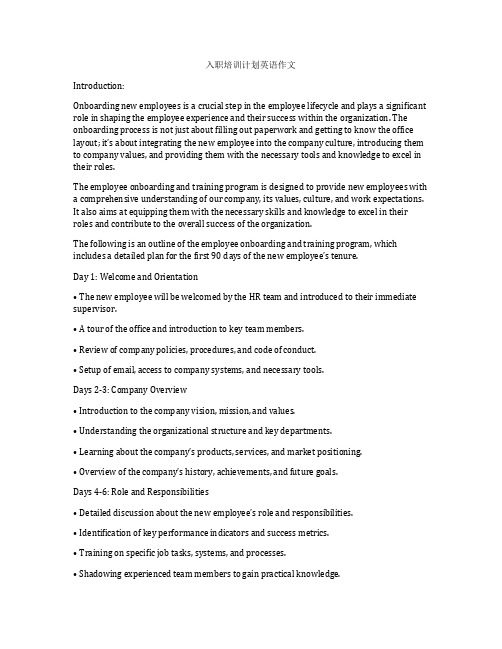
入职培训计划英语作文Introduction:Onboarding new employees is a crucial step in the employee lifecycle and plays a significant role in shaping the employee experience and their success within the organization. The onboarding process is not just about filling out paperwork and getting to know the office layout; it’s about integrating the new employee into the company culture, introducing them to company values, and providing them with the necessary tools and knowledge to excel in their roles.The employee onboarding and training program is designed to provide new employees with a comprehensive understanding of our company, its values, culture, and work expectations. It also aims at equipping them with the necessary skills and knowledge to excel in their roles and contribute to the overall success of the organization.The following is an outline of the employee onboarding and training program, which includes a detailed plan for the first 90 days of the new employee’s tenure.Day 1: Welcome and Orientation• The new em ployee will be welcomed by the HR team and introduced to their immediate supervisor.• A tour of the office and introduction to key team members.• Review of company policies, procedures, and code of conduct.• Setup of email, access to company systems, an d necessary tools.Days 2-3: Company Overview• Introduction to the company vision, mission, and values.• Understanding the organizational structure and key departments.• Learning about the company’s products, services, and market positioning.• Overview of the company’s history, achievements, and future goals.Days 4-6: Role and Responsibilities• Detailed discussion about the new employee’s role and responsibilities.• Identification of key performance indicators and success metrics.• Training on speci fic job tasks, systems, and processes.• Shadowing experienced team members to gain practical knowledge.Days 7-30: Functional Training• Functional training related to the new employee’s role (e.g., marketing, sales, finance).• Introduction to tools and software used in day-to-day work.• On-the-job training and practical assignments.• Regular feedback and coaching sessions with the manager.Days 31-60: Skill Development• Focus on developing specific skills required for the role (e.g., communication, le adership, time management).• Participation in relevant workshops, seminars, and online training programs.• Mentorship opportunities with senior employees.• Progress review and goal setting for the next phase.Days 61-90: Project Involvement• Involvement in real-time projects relevant to the role.• Collaboration with cross-functional teams.• Presentation of project insights and learnings to the management team.• Final evaluation and review of the onboarding and training program.Ongoing Support:• Throughout the onboarding and training program, regular check-ins will be conducted with the new employee to ensure they are adjusting well and receiving the necessary support.• The HR team will be available to address any concerns, provide guidanc e, and advocate for the new employee’s needs.• Managers will continue to provide feedback, mentorship, and support for ongoing development.Evaluation and Feedback:• At the end of the 90-day program, a comprehensive evaluation will be conducted to assess the new employee’s progress, skill development, and overall integration into the company.• Feedback will be collected from the new employee, their manager, and other stakeholders to identify areas of improvement and potential gaps in the onboarding and training program.Conclusion:The employee onboarding and training program is designed to create a seamless and enriching experience for new employees as they embark on their journey with our company. By providing a structured and comprehensive onboarding process, we aim to set our employees up for success from day one and ensure their long-term engagement and contribution to the organization.This onboarding and training program is a dynamic and evolving process, which will be continuously reviewed and improved to meet the changing needs of the organization and its employees.We look forward to welcoming new team members and providing them with the necessary support and resources to excel in their roles and become valuable assets to our company.。
新精英培训计划
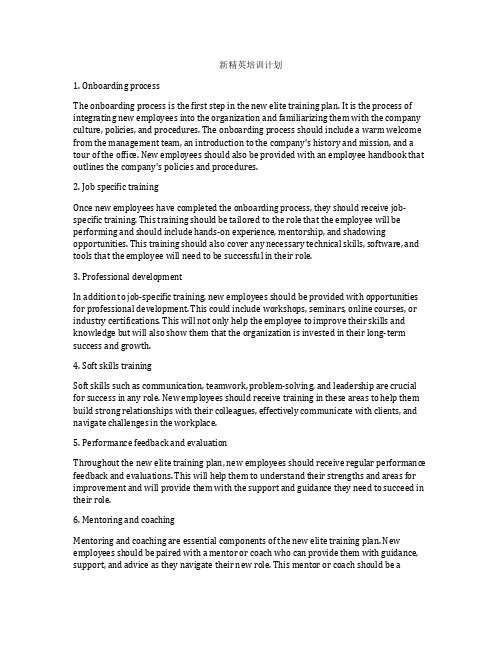
新精英培训计划1. Onboarding processThe onboarding process is the first step in the new elite training plan. It is the process of integrating new employees into the organization and familiarizing them with the company culture, policies, and procedures. The onboarding process should include a warm welcome from the management team, an introduction to the company's history and mission, and a tour of the office. New employees should also be provided with an employee handbook that outlines the company's policies and procedures.2. Job specific trainingOnce new employees have completed the onboarding process, they should receive job-specific training. This training should be tailored to the role that the employee will be performing and should include hands-on experience, mentorship, and shadowing opportunities. This training should also cover any necessary technical skills, software, and tools that the employee will need to be successful in their role.3. Professional developmentIn addition to job-specific training, new employees should be provided with opportunities for professional development. This could include workshops, seminars, online courses, or industry certifications. This will not only help the employee to improve their skills and knowledge but will also show them that the organization is invested in their long-term success and growth.4. Soft skills trainingSoft skills such as communication, teamwork, problem-solving, and leadership are crucial for success in any role. New employees should receive training in these areas to help them build strong relationships with their colleagues, effectively communicate with clients, and navigate challenges in the workplace.5. Performance feedback and evaluationThroughout the new elite training plan, new employees should receive regular performance feedback and evaluations. This will help them to understand their strengths and areas for improvement and will provide them with the support and guidance they need to succeed in their role.6. Mentoring and coachingMentoring and coaching are essential components of the new elite training plan. New employees should be paired with a mentor or coach who can provide them with guidance, support, and advice as they navigate their new role. This mentor or coach should be aseasoned professional who can offer insights and experiences that will help the new employee to excel in their role.7. Team building activitiesTeam building activities are important for helping new employees to build relationships with their colleagues and to feel like they are part of the team. These activities could include team lunches, off-site retreats, or team-building exercises. This will help new employees to integrate into the organization and build strong working relationships with their colleagues.8. Ongoing support and resourcesFinally, the new elite training plan should include ongoing support and resources for new employees. This could include access to a knowledge base, regular check-ins with their manager, and opportunities for further training and development. This ongoing support will help new employees to feel supported and empowered as they settle into their new role.In conclusion, a comprehensive new elite training plan is essential for helping new employees to integrate seamlessly into the organization and reach their full potential. By providing onboarding processes, job-specific training, professional development opportunities, soft skills training, performance feedback, mentoring and coaching, team building activities, and ongoing support and resources, organizations can ensure that new employees are well-equipped to excel in their roles. This will not only benefit the individual employees but also the organization as a whole.。
新员工入职工作计划英文
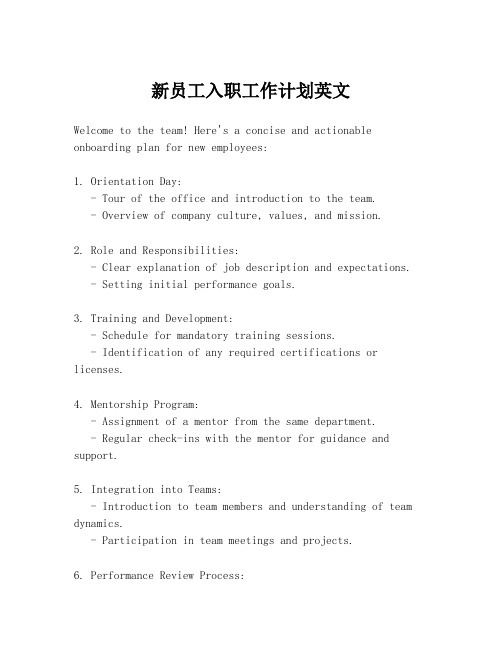
新员工入职工作计划英文Welcome to the team! Here's a concise and actionable onboarding plan for new employees:1. Orientation Day:- Tour of the office and introduction to the team.- Overview of company culture, values, and mission.2. Role and Responsibilities:- Clear explanation of job description and expectations. - Setting initial performance goals.3. Training and Development:- Schedule for mandatory training sessions.- Identification of any required certifications or licenses.4. Mentorship Program:- Assignment of a mentor from the same department.- Regular check-ins with the mentor for guidance and support.5. Integration into Teams:- Introduction to team members and understanding of team dynamics.- Participation in team meetings and projects.6. Performance Review Process:- Explanation of the performance review cycle.- Setting up initial milestones for the first review.7. Communication Channels:- Familiarization with internal communication tools.- Guidelines on professional communication within the company.8. Resource Access:- Access to company intranet, databases, and other resources.- Introduction to IT support for any technical needs.9. Feedback Mechanism:- How to provide and receive constructive feedback.- Understanding the importance of feedback for growth.10. Social and Networking Opportunities:- Information on company social events and networking opportunities.- Encouragement to participate in team-building activities.11. Health and Wellness:- Details on employee wellness programs.- Access to health and safety information.12. Continuous Learning:- Opportunities for professional development and further education.- Encouragement to stay updated with industry trends.13. Exit Interview Preparation:- Understanding the purpose of exit interviews.- How to prepare for an exit interview if the need arises.14. Evaluation of Onboarding Process:- Feedback form for new employees to evaluate the onboarding experience.- Opportunities for new employees to suggest improvements.This plan is designed to ensure a smooth transition into the company and to set the stage for a successful career with us. Remember, your success is our success, and we're here to support you every step of the way.。
某公司新员工培训管理手册英文版
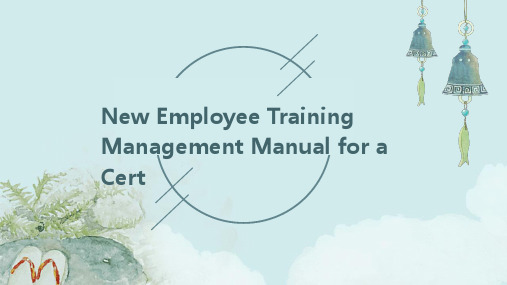
Practical operation training
By simulating actual work scenarios, conducting practical operations and team collaboration training, we aim to cultivate the practical skills and teamwork spirit of new employees.
03
Training methods and approaches
Use of online learning management systems (LMS) to provide courses, videos, and materials for self-study
E-learning Platforms
Job related training
The training should be closely aligned with the job requirements and responsibilities of the new employees
Flexibility
The training program should be flexible, allowing for individong new employees
The company lies in a continuous learning approach, providing opportunities for employees to develop their skills and knowledge through their employment
Blending different methods resources active participation and enhancement retention of information
新员工上岗特殊培训计划

新员工上岗特殊培训计划一、培训目的新员工上岗特殊培训是为了让新员工在进入公司后尽快融入公司文化,熟悉工作岗位,提高工作效率,确保新员工能够迅速适应工作环境,达到公司对新员工的要求。
二、培训内容1. 公司概况及组织架构通过公司介绍,让新员工了解公司的发展历程、企业文化、愿景使命等基本情况,同时介绍公司的组织结构和岗位设置,让新员工对公司有一个整体的认识。
2. 工作流程及规范针对不同岗位的员工,介绍各自的工作流程和规范,包括工作流程、工作标准、工作目标等,让新员工了解自己工作的重点和方向。
3. 产品知识对于销售岗位的员工,需要掌握公司的产品知识,包括产品特点、使用方法、市场定位、竞争对手等重要信息,以便能够更好的推广和销售产品。
4. 客户服务公司客户服务部门的员工需要接受客户服务方面的培训,包括服务技巧、服务流程等,让员工了解如何更好的服务客户,让客户满意。
5. 沟通技巧无论什么岗位,沟通是非常重要的,培训要求新员工学习沟通技巧,包括口头沟通和书面沟通,让员工能够更好的和同事、客户、上级进行沟通。
6. 团队协作团队协作是公司中非常重要的一个方面,培训要求新员工学习团队协作的重要性,了解如何更好的和同事协作,让工作更高效。
7. 安全生产对于从事生产制造等工作的员工,需要接受安全生产方面的培训,包括生产流程、作业规范、安全防护措施等,确保员工的安全和生产顺利进行。
8. 公司政策和制度培训中要求对公司的各项政策和制度进行介绍,包括公司福利、薪酬制度、考核制度等,让新员工了解公司对员工的保障和要求。
三、培训方式1. 专业讲师授课公司可以邀请专业的讲师进行培训,包括公司内部的专家,也可以邀请外部的专业人士,让新员工能够从专业的人士那里了解更多相关知识。
2. 实操演练针对一些需要实际操作的岗位,可以安排实操演练课程,让新员工在课堂上进行学习,同时进行实际操作,加深学习效果。
3. 游戏互动培训中也可以加入一些游戏活动,让新员工在轻松的氛围中学习知识,增强学习的趣味性和参与感。
- 1、下载文档前请自行甄别文档内容的完整性,平台不提供额外的编辑、内容补充、找答案等附加服务。
- 2、"仅部分预览"的文档,不可在线预览部分如存在完整性等问题,可反馈申请退款(可完整预览的文档不适用该条件!)。
- 3、如文档侵犯您的权益,请联系客服反馈,我们会尽快为您处理(人工客服工作时间:9:00-18:30)。
附件十一:识别卡片 信用卡功能 受卡流程
CP-FO-B13
注意事项 功能键 结算及签到
CP-FO-B14
How To Use 商友系统附件十二:业主现金卡结算操作程序 附件十三:商友系统操作指南
CP-FO-B15
Hotel Discount Summery 酒店折扣信息汇总
附件八:Hotel discount Info
CP-FO-B04
CP-FO-B05
CP-FO-B06
叫醒记录表的填写
CP-FO-B07
客房保险箱及前台保险箱 普通物品--礼宾部 贵重物品--值班经理 发票类--前台(6#柜)
CP-FO-B08
CP-FO-B09
CP-FO-B10
内部员工拿停车票需要登记
CP-FO-B11
记录并报告至相应负责部门
CP-FO-B12
Remark 明 前台设施及物品存放 前台日常工作任务及工作职责
说
Trainer 培训师
Check By
CP-FO-B02
客人信息,酒店财务及内部资料
CP-FO-B03
附件七:Hotel terminology 附件八:常用简写 附件九:如何使用PSB系统 有效证件及登记准则 如何办理住宿证明 附件十:Message Format
Code 序号 CP-FO-B01
Training Task 培训任务 Introduce FD 前台简介 Confidentiality Policy 保密政策 Hotel Enlish & Abbreviation 酒店专业术语及常用简写 PSB Regulation 外管条列 Message Service 言服务 Wake Up Call Service 叫醒服务 Savety Box Service 贵重物品保管服务 Hand over item 物品转交寄存服务 Lost & Found 失物招领 Car Parking Service 车票管理 Guest Request & Feedback 客人需求及意见反馈 Credit Card knowledge Training 信用卡培训 How to use POS machine 如何使用刷卡机 停 留
